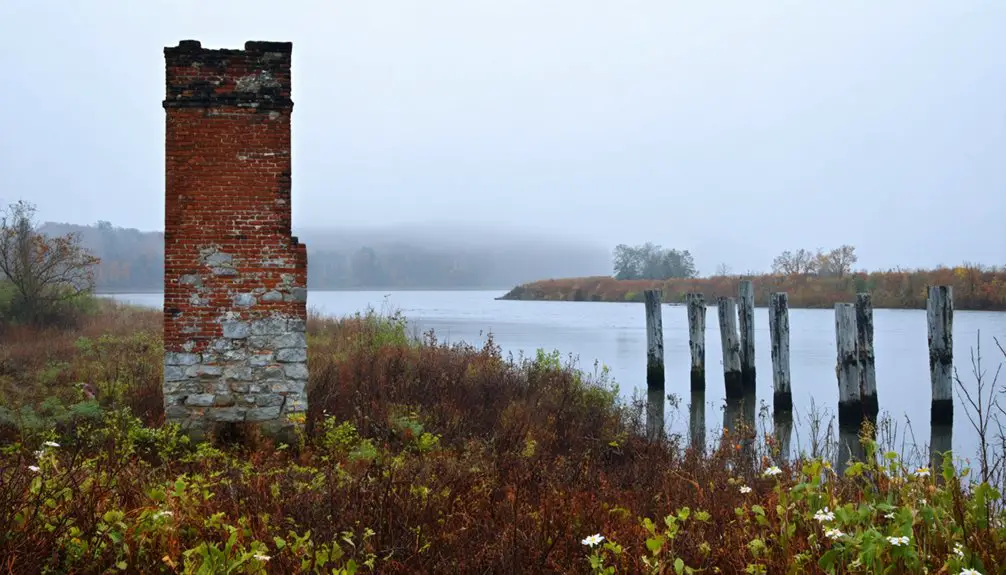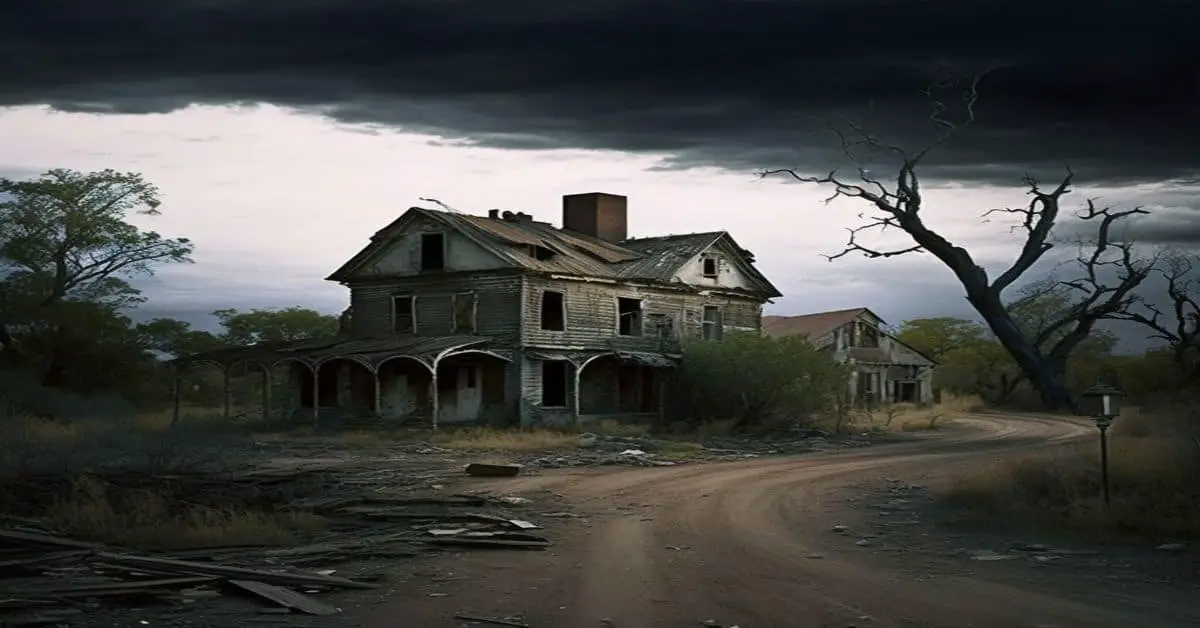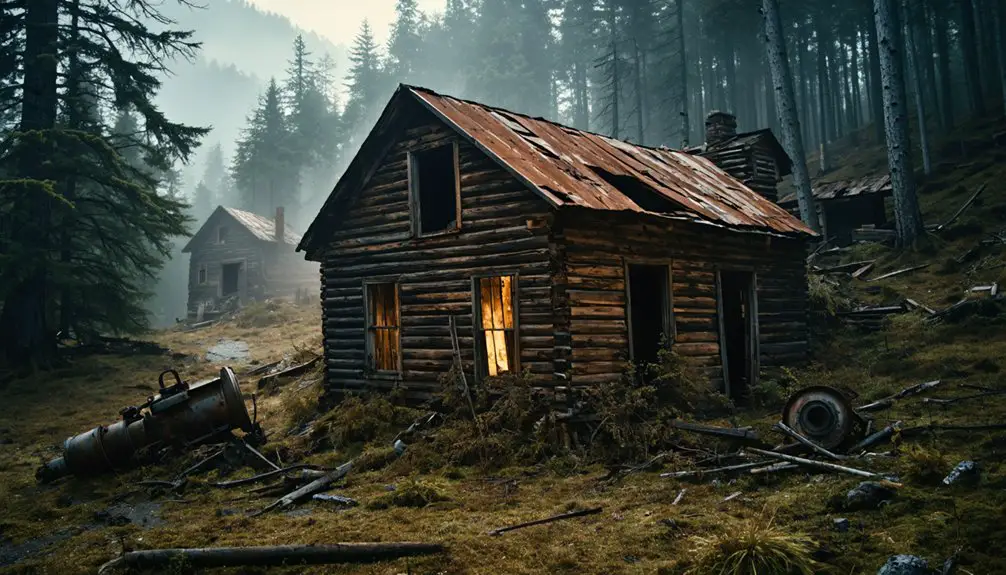You’ll find Lapidum’s ghostly ruins within today’s Susquehanna State Park, where this once-bustling Maryland river port thrived in the 19th century. The town’s strategic location and fertile soil attracted early settlers, leading to prosperous trade networks via ferry and canal operations. Railroad competition and devastating ice gorges ultimately sealed Lapidum’s fate, but you can still explore the Victorian-era foundations, including Conrad Baker’s hotel and the historic Tidewater Canal’s Lock 9. The town’s haunting story of rise and decline awaits your discovery.
Key Takeaways
- Lapidum was once a thriving commercial port town on Maryland’s Susquehanna River before becoming abandoned in the late 19th century.
- Railroad competition and lack of a major rail stop caused economic decline as trade shifted to better-connected communities.
- Devastating ice gorges destroyed essential waterfront infrastructure, making recovery financially impossible for the riverside community.
- The town’s ruins, including hotel foundations and canal remnants, are now preserved within Susquehanna State Park.
- Visitors can explore historical foundations of the church, mill, and Masonic Hall through marked trails and parking areas.
The Early Settlement Years (1665-1800)
Three significant land patents – “Paradise,” “Elberton,” and “Vincent’s Castle” – marked the beginning of Lapidum’s settlement in 1683 along the western bank of the Susquehanna River.
As you explore the settlement patterns of this early Maryland community, you’ll find that pioneers were drawn to the area’s fertile soil and strategic location opposite Port Deposit.
Early agriculture flourished as settlers transformed the wilderness into productive farmland, primarily growing corn and tobacco.
You’d have seen these hardy farmers supplementing their crops by fishing for shad and herring in the river.
The establishment of ferry services connected Lapidum to Port Deposit and Peach Bottom, making it a crucial transportation hub.
The area’s commercial significance grew as it became a vital trading center for northern Maryland and southern Pennsylvania.
This vital ferry service continued operations until Rock Run bridge was completed in 1818.
Rise to Commercial Prominence
As Lapidum entered the 19th century, its strategic location at the head of navigation on the Susquehanna River transformed it into a bustling commercial hub.
You’d find yourself at the heart of extensive trade networks, where the Susquehanna ferry and Tidewater Canal connected local farmers to distant markets. The three-story Victorian Susquehanna Hotel, built in 1868, welcomed travelers while warehouses stored valuable cargo from ships. A ferry service operated continuously from the 1720s until 1818.
The town’s agricultural commerce thrived as corn, tobacco, and flour from the Rock Run merchant mill made their way to Caribbean markets. Ice accumulation damage repeatedly destroyed the wharves and warehouses, hampering the town’s commercial operations.
John Stump’s warehouses bustled with grain, pig iron, and farm products. Supporting this commercial growth, you’d see a vibrant community complete with a church, Masonic hall, and school – all evidence of Lapidum’s rising prosperity as a crucial transportation crossroads.
Life Along the Susquehanna
While the Susquehanna River shaped nearly every aspect of Lapidum’s daily life, it was the seasonal rhythms of farming and fishing that truly defined the community.
You’d find locals working the fertile fields along the riverbanks, growing corn and tobacco, while others cast their nets for the abundant shad and herring runs. In winter, you’d see teams harvesting ice from the river’s frozen surface for commercial use.
The river’s presence touched everything – from the bustling ferry crossings that connected you to neighboring towns, to the Victorian hotel where you’d gather with fellow community members.
You’d trade at the local stores, worship at the church, and send your children to the schoolhouse. Life flowed with the river’s rhythms until railroads and environmental challenges gradually altered this water-dependent way of life.
Economic Peak and Victorian Era
During Lapidum’s golden age, you’d find the bustling waterfront alive with merchants loading their wares onto ferries and canal boats, while workers hauled pig iron, grain, and flour between the town’s numerous warehouses and wharves.
The 1868 construction of the three-story Victorian Susquehanna Hotel marked the town’s architectural pinnacle, featuring grand porches that welcomed travelers and served as a social hub for the thriving merchant class.
The hotel’s prominence, alongside the Masonic hall, church, and various businesses, reflected Lapidum’s status as one of the Chesapeake Bay’s most important deepwater ports, connecting northern Maryland’s markets with southern Pennsylvania’s commercial centers.
River Trade Golden Age
The establishment of Thomas Cresap’s ferry service in 1729 marked the beginning of Lapidum’s golden age as a bustling river trade hub.
You’d have seen ferries bustling back and forth across the Susquehanna, carrying corn, tobacco, and fish to enthusiastic markets in Port Deposit and beyond. The waterfront teemed with activity as ships loaded with lumber, coal, and flour made their way through the Maryland Canal.
At the heart of river commerce, Lapidum’s warehouses and wharves served as crucial links between northern Maryland and southern Pennsylvania.
You could’ve witnessed merchants trading shad and herring while farmers brought their harvests to market. The town’s strategic position as the northernmost navigable deep-water point made it an essential stop for goods headed to Baltimore and the Chesapeake’s trade routes.
Victorian Architecture Prominence
Prosperity from Lapidum’s river trade brought an architectural renaissance to the town, most prominently through its grand Victorian buildings.
You’d have witnessed this transformation most significantly in 1868, when Conrad Baker erected a magnificent three-story Victorian hotel at the intersection of Lapidum and Stafford Roads.
Similar to the Queen Anne mansion built for Murray Vandiver in 1886, the Victorian aesthetics of these structures reflected the community’s wealth and sophistication. You would’ve seen intricate woodwork, gabled roofs, and elaborate porches adorning these multi-story buildings.
The architectural legacy lives on through documented features like stained glass windows and tiled fireplaces, typical of the era’s opulent design principles.
The Susquehanna Hotel, in particular, served as both a symbol of Lapidum’s economic success and a crucial hub for merchants and travelers during the town’s golden age.
The hotel’s construction utilizing stone and brick materials exemplified the durability and grandeur of Victorian-era commercial architecture.
Susquehanna Hotel’s Social Impact
Built in 1868, Lapidum’s Susquehanna Hotel quickly became the social heartbeat of this bustling river town, where you’d find merchants negotiating deals over breakfast and dock workers unwinding after long shifts.
The hotel’s strategic location near churches and Masonic halls made it the perfect venue for social gatherings, from community events to business meetings.
You’d see the hotel’s impact everywhere – from the local laborers who built its Victorian stone facade to the staff who served travelers arriving by river and road.
Standing as an impressive three-story Victorian structure, the hotel dominated the local landscape and served as a landmark for river traffic.
Even as railroad competition emerged around 1900, the hotel adapted, transforming into a men’s club and fishing lodge.
For nearly a century, it provided jobs and stability to Lapidum’s economy while maintaining its role as the town’s primary social center until its demolition in the 1960s.
Factors Leading to Abandonment
If you’d visited Lapidum in the late 1800s, you’d have witnessed the dramatic impact of railroad competition as faster freight transit options drew commerce away from the town’s once-bustling canal and ferry operations.
The town’s inability to secure a major rail stop effectively sealed its commercial fate, as surrounding communities with rail access absorbed the trade that had previously flowed through Lapidum’s port.
Nature dealt additional blows through devastating ice gorges on the Susquehanna River, which repeatedly destroyed the town’s essential wharves and waterfront infrastructure, making economic recovery increasingly difficult.
Railroad Competition Impact
While Lapidum once thrived as an essential river transportation hub, the arrival of extensive railroad networks in the late 19th century fundamentally altered the town’s destiny.
You’d have witnessed fierce railroad competition as the Western Maryland Railway, Pennsylvania Railroad, and Baltimore & Ohio battled for dominance, creating alternative routes that bypassed your once-bustling river town.
Without modern rail infrastructure like depots and turntables, Lapidum couldn’t compete with larger hubs.
The Western Maryland Railway’s completion of its Port Covington terminal in 1904 further diminished Lapidum’s importance as a shipping point.
Transportation costs dropped significantly, with lumber rates falling from $3.00-$3.50 to $1.12 per 1,000 feet by rail.
The transportation decline hit hard as ferry services closed and steamboat traffic dwindled. Your local economy, built on agriculture, fishing, and ice harvesting, couldn’t match the industrial-scale operations of railroad towns.
As residents moved toward railway cities, Lapidum’s hotels, stores, and mills saw their customers vanish, leaving behind empty buildings and quiet streets.
Natural Disasters Strike Hard
Beyond the economic blow dealt by railroad competition, devastating natural disasters hammered Lapidum’s riverfront infrastructure throughout the late 19th century.
You’ll find the most destructive force came from massive ice jams, known locally as “ice gorges,” that repeatedly formed along the Susquehanna River near town. These natural disasters dealt crushing blows to Lapidum’s commercial heart:
- Ice formations physically destroyed the warehouses and wharves essential to river trade
- Repeated flooding weakened remaining structures beyond repair
- The constant battle against nature made maintaining river infrastructure financially impossible
The relentless assault from these ice gorges accelerated Lapidum’s decline, forcing businesses to abandon their riverfront operations.
Eventually, nature reclaimed the town’s commercial district, leaving only ruins as evidence of its once-thriving river trade.
Legacy and Present-Day Remnants

Today you’ll find Lapidum’s remnants scattered throughout Susquehanna State Park, where crumbling foundations and overgrown pathways tell the story of a once-thriving river town.
The most notable remains include the foundation of Conrad Baker’s Victorian hotel, which served as a fishing lodge until the 1960s, and the preserved Loch 9 of the Tidewater Canal.
The state park’s historical preservation efforts have made these ruins accessible to curious visitors through parking areas and interpretive signage.
You can explore the ghostly foundations of the town’s church, mill, and Masonic Hall, while learning about Lapidum’s essential role in regional commerce.
Though nature has reclaimed much of the landscape, community engagement keeps the town’s memory alive through local heritage programs and historical documentation.
Frequently Asked Questions
What Native American Tribes Originally Inhabited the Lapidum Area?
You’ll find the Susquehannocks were the primary Native tribes in this area, with cultural significance along the river, while Algonquian peoples like the Piscataway and Nanticokes inhabited nearby regions.
Were There Any Notable Crimes or Outlaws in Lapidum’s History?
Through time and tides, you won’t find records of notable Lapidum crimes or outlaws. Historical documents focus on peaceful commerce and community growth rather than criminal activity in this river town.
How Many People Lived in Lapidum During Its Peak Population?
You’ll find Lapidum’s peak population wasn’t officially recorded, but based on the town’s infrastructure and commercial activity during the mid-1800s, it’s estimated several hundred people called this river community home.
What Happened to the Residents When They Abandoned Lapidum?
Like birds seeking warmer shores, residents drifted toward thriving cities nearby – mainly Havre de Grace and Port Deposit – where they found new jobs and built fresh lives away from Lapidum’s decline.
Are There Any Documented Paranormal Activities in Lapidum’s Remaining Structures?
You won’t find documented ghost sightings or haunted history in these ruins. Despite being a ghost town, research shows no verified paranormal activity in the remaining structures of this old settlement.
References
- https://en.wikipedia.org/wiki/Lapidum
- https://kids.kiddle.co/Lapidum
- https://dnr.maryland.gov/publiclands/pages/central/susquehanna/history-susquehanna.aspx
- https://en.wikipedia.org/wiki/List_of_ghost_towns_in_Maryland
- https://kids.kiddle.co/List_of_ghost_towns_in_Maryland
- https://www.hmdb.org/m.asp?m=188601
- http://outtaway.blogspot.com/2014/01/ghost-town-of-lapidum-maryland.html
- https://www.hmdb.org/m.asp?m=213917
- https://dnr.maryland.gov/publiclands/documents/historicwalkingsusquehanna.pdf
- https://archive.org/download/historicalsketch00maso/historicalsketch00maso.pdf



